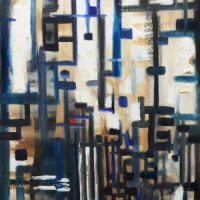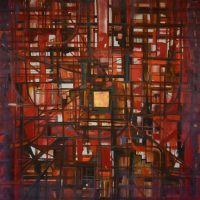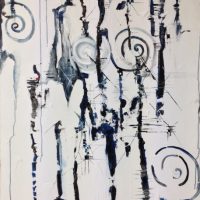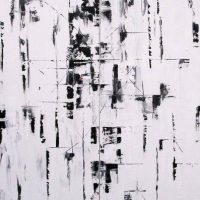
MARIA BARROS ABREU – Invisible Cities
We have the pleasure to exhibit Invisible Cities by Maria Barros Abreu.
Press Release
With cities, it is as with dreams: everything imaginable can be dreamed, but even the most unexpected dream is a rebus that conceals a desire or, its reverse, a fear. Cities, like dreams, are made of desires and fears, even if the thread of their discourse is secret, their rules are absurd, their perspectives deceitful, and everything conceals something else.
– Calvino (1974), p 44
“Invisible cities” are a genetical paradox in the work of Maria Barros Abreu. This plastic artist has a multiple and proficient professional career and her work explore the complexity of feelings and relationships which identify what is intrinsic to the human being.
By its very nature, art is the disclosure of the character of what is visible, redefining it constantly. The process of making a landscape of connections between matrix places understandable enables both the vulnerability of existence and the stream (that allows Life) to come to light. The appearance of veiling techniques, the mystery of transparencies or the sagacity of overlaps are legendary battles in a sagacious quest for meaning.
As humans, we are permanent builders of reality. We build more than buildings, we institute more than institutions. There are lines that can be seen, that meet in an infinite number of relationships. There are concealed lines that emerge on a road, which connects us, or in a house made to be inhabited, to bear life, to look after. The city on its own is but a bloodless body.
The canvases about “Invisible cities” stand for that creative and emotional dependence of people with other people, from the utmost vital need of being cared, to the overcoming of distance or rather the solitary experience. The effects of fog, the textures or the strength of the painting-knife strokes compete in a dreamlike fantasy which provides a background to the whole narrative. Individuals, who inhabit the space, who bear it to life, appear in the canvases in the form of a relationship – contexts of belongingness hued by thoughts about their paths, knowledge of their past life and confident expectations for their future.
These “invisible cities” are flows, elongated human efforts to overcome difficulties and give meaning to the energy, which throbs inside each living Being, converting space into their own home. The cities nourish the dream of a transposable nature, where together, the living beings become human beings and turn out to be more and better capable. Light, water, warmth, fruits. With or without Sunshine, with or without Rain, with or without Fire, with or without Earth. In each City the combination of materials and mixed techniques stimulates the reinvention of a prodigal and uncertain existence. Limitless.
Urban living beings, so many times invisible to the political power, to the capital, to greediness, assumed as a means to reach the goal, come one after the other in a plot of straight lines, angles and settings, which complement each other, as if they were faceless destinies.
“Invisible cities” support the essential creating codes to look and… see. To look at the structure that proudly raises and protects. To see in order to understand the subtle relationships between characters that could be us. In the midst of roads and streets that lead to places where we live or could live, between encounters and efforts that transfuse in a sanguineous willingness to survive. There’s always a red color that stops us or that stirs in a provocative vital movement.
Between what is real or imagined, there are sceneries of “Invisible cities” that could be our cities, an identity that renews itself in delight and rebellion, in memory and forgetfulness, in assimilation and nonconformity.
An intense demand to be alive and show it. An every day whirl to make new stuffs, new connections, different landscape. The viewer´s eyes permanently organized and disorganized the City. Eyes and hands that work, flow raise and love… with no prophecies. Invisible.
Margarida Matos Barros
Biography
Maria Abreu de Barros lives and teaches at her own atelier in Viseu.
Starts her academic career in Soares dos Reis School of Decorative Arts (Porto) followed by a Painting Course in Ricardo Espírito Santo Silva Foundation (Lisbon) and a degree in Preservation and Restore at Decorative Arts College (Lisbon).
She exhibits regularly since 1994
Individual exhibitions:
2003
“4 Montras” Art Gallery (Viseu)
2005
“Aquários” Art Gallery (Guarda)
2005/2007
“Nacional” Art Gallery (Coimbra)
2008
“Arte G” Art Gallery (Viseu)
2010
“Cantinho dos Reis” Art Gallery (Coimbra) A relevant moment in her career includes a Live Painting Performance (2013) based on João Pedro Oliveira musical composition for the 6th Spring Musical Festival (Viseu)
Group exhibitions:
1994/95/96/97/98/99
Turismo Dão Lafões, Viseu;
1997
Sátão City Council
1997
Viseu City Council
2002
“Art Bar” Art Gallery – Viseu
2004
“Nacional” Art Gallery – Coimbra
2005
Portuguese Association of Business Women - “Art Bar” Art Gallery – Viseu
2005
Tribute to Fernando Pessoa - “Nacional” Art Gallery – Coimbra
2005
Tribute to Fernando Pessoa - Porto de Moz City Council
2007
“ArteG” Art Gallery – Viseu
2007
Tribute to Miguel Torga - “Nacional” Art Gallery – Coimbra
2007
Tribute to Miguel Torga - Porto de Moz City Council
2008
Tribute to Miguel Torga - Order of Portuguese Lawyers– Coimbra
2009
“Nacional” Art Gallery – Coimbra
2009
“ArteG” Art Gallery – Viseu
2010
Montebelo Hotel – Viseu
2010
“ArteG” Art Gallery – Viseu
2010
Tribute to Zeca Afonso “Nacional” Art Gallery– Coimbra
2011
Montebelo Hotel – Viseu
2011
“ArteG” Art Gallery – Viseu
2012
“Nacional” Art Gallery – Coimbra
2012
“ArteG” Art Gallery – Viseu
Her work is represented in private and public collections.














